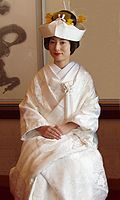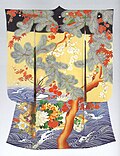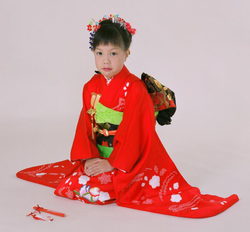Kimono
Kimono 着物 (きもの) are traditional Japanese style clothes. About a hundred years ago, most people in Japan wore kimono every day.[1] Now, people wear the kimono for special occasions, fun, and fashion. For example, a Japanese couple might wear kimono on their wedding day.
A kimono is a robe. When it lies flat, it is shaped like a letter T.[2] Normal kimono reach to the ankles and have long sleeves. The sleeves of some kimono for women also reach to the ankles, but most kimono sleeves reach to the hips. Kimono come in many different designs and colours. Some colours have meanings.[3]
Name
History

The kimono that people wear today began in the 16th century.[3] But Japanese people have been wearing clothes that looked like the kimono for hundreds of years, since the Heian period (late 700s to late 1100s).[6][7]
Chinese visitors brought the kimono to Japan. The Japanese decided to make and wear kimono too.[5] These clothes had long, triangle-shaped sleeves and were wrapped over the body. The kimono had two parts: a jacket and either a skirt or trousers.
These clothes changed to look more like the kimono we see today. The kimono looked less like a triangle and more like a rectangle. The sleeves became square instead of triangle-shaped.
Common people wore a piece of clothing called a kosode, which means "short sleeve". This looked like a modern kimono with a wider body and smaller sleeves. The overlap at the front of the robe was longer, the collar was wider, and the robe was shorter.
Noble people also wore the kosode, but they wore several layers on top of it. Noble women wore clothing called jūni hitoe, which means "twelve layers", though the number of layered robes was not always twelve. These robes were wider, longer, and had larger sleeves than the kosode that the common people wore. They weighed up to 20 kg. Noblemen wore round-necked jackets with wide, long sleeves and hakama trousers. They would wear this with a small cap, which was usually black in colour.
Over time, wearing many layers of clothes became unfashionable. The government created laws to stop people from wearing many robes at once. Starting in the Muromachi period, women and men began to wear the kosode by itself or with two or three layers, with a small, thin belt called an obi, and for women, red hakama trousers. However, ceremonial clothing in the Imperial Court still looked like clothing from earlier times. Even today, the new Emperor and Empress of wear in clothes from the Heian period when they are formally named king or queen.
During the Genroku period, the common people had more money, especially merchants. They wore expensive and beautiful kosode, even if they were not nobles. People began to decorate their clothing in new ways, for example stitched patterns in thread, and new ways of coloring their clothing.
This made them look like noble people, so the government introduced laws against commoners wearing some kinds of clothes. However, people did not want to give up their beautiful clothes. Instead, they found different ways of wearing them; a man, for instance, might wear a haori jacket made out of wool in a plain, boring colour, but he could line it with beautiful silk fabric.
This way of thinking about clothing and appearances became known as an aesthetic idea called iki, which is still important to the way people wear kimono today.
From the 1600s into the 1800s, Japan's leaders decided the country should not have contact with other countries. Only a few Dutch ships were allowed to land and trade. The Dutch traders saw the kimono and knew people in Europe would like them. They asked Japanese kimono-makers to make kimono with rounder sleeves and warmer cuts for the Europeans to buy and wear. Kimono became popular with rich Europeans. When the Japanese kimono-makers could not make enough kimono for the Dutch traders to sell, the Dutch traders told clothiers in India to copy the kimono.[2]
Over time, the obi became wider and longer, especially for women. Because of this, the sleeves of women's kosode were no longer sewn to the body entirely. They were instead only attached at the shoulder.
Sleeves became got longer for young women, as did the length of the kosode. In the Edo period, people began to say kimono instead of kosode. The kimono would trail behind the wearer. This was not a problem indoors. Outside, the wearer had to pull up the kimono so it would not become dirty. Women started tucking the extra length of their kimono into a hip fold, which became known as the ohashori. Kimono are still worn by women today with the ohashori.
During the Meiji Period, Japan's government decided the country should be more modern. They built railroads and improved the army and universities. But they also changed customs. Fewer people wore the kimono every day. Instead, they wore modern, Western clothes.[5]
Over time, very wide obi and very long kimono fell out of fashion. During World War Two, people thought long kimono sleeves were wasteful. Sleeves on kimono were shortened, sometimes a lot. This new sleeve length lasted, and modern kimono for women are still shorter than they were before the war. Older kimono, especially from the Taishō period, still have these long sleeves.
Today, more women wear the kimono than men. Men wear kimono most often at weddings and at Japanese tea ceremonies.
Men's and women's kimono
Kimono come in different sizes for different people. They come in different lengths for men and women. Men and women also wear kimono with different sleeves.
Kimono for women are much longer than kimono for men, and women fold the kimono at the waist to make it the right length. The right length for a woman's kimono is usually the same as her height.
The sleeves on a woman's kimono are not sewn to the body all the way down, and they are open at the back. Part of the body of the kimono is open as well. The sleeves on a woman's kimono are longer than the sleeves on a man's kimono, and sometimes they reach the ankle on kimono for young women. The curve at the edge of the sleeves is very round, especially on kimono for young women and girls.
Kimono for men do not need to be folded at the hip, and so do not have any extra length. The sleeves are shorter, and they are attached almost all the way down to the body. The back of each sleeve is sewn shut, and the body is also sewn shut. The curve at the edge of the sleeve is not as round.
Kimono for men are usually one solid colour, but they might have a very small geometric design. Kimono for women can be one solid colour, have a small design, or be decorated in larger, colourful patterns. More colourful kimono are usually worn by young women. Sometimes, these designs are only worn in certain seasons of the year.
People who are very tall or very heavy can struggle to find a kimono that fits them, and sometimes have kimono made for them instead.
Types of kimono
Kimono come in different types for different occasions, and both men and women have formal and casual kimono. Formal kimono have a number of crests on them, called kamon or mon. These are placed on the front of the shoulders, the back of the sleeves, and the centre of the back. Kimono with crests have either one, three, or five crests on them - the crest on the centre back, the centre back and the sleeves, or the centre back, the sleeves and the shoulders.
The most formal kimono have all five of these crests on them. The least-formal formal kimono have just one. These crests can be outlined or coloured in fully in white, with kamon that are just an outline being the least formal.
Kimono are usually made of silk, but there are cotton, polyester, hemp and linen kimono as well. Some kimono are also made of wool, or rayon. Formal kimono are always made out of fine silk, and are usually sewn by hand. However, not all silk kimono are formal kimono, and some types of silk, such as pongee (known as tsumugi) are only ever worn to casual occasions.
The most informal type of kimono is the yukata, worn in summer[8] to festivals and in bath houses and inns by both men and women. They are not lined, are always made of cotton, and are worn with thin, brightly coloured obi.
For formal occasions, men wear fine silk kimono with haori (a kimono jacket) and hakama (loose-fitting trousers). The hakama are usually striped in white and black, and the kimono and the haori will match in colour.
Women have a number of different types of kimono for different formal occasions. The designs on the kimono, how they are put onto the kimono, and where they are placed on the kimono all change how formal the finished outfit is. In order of formality, these are:
- Komon - a kimono with patterns on it. [9]
- Edo komon - a komon with a very, very small pattern repeating all over, usually in white on a coloured background. From a distance, these kimono look like one, solid colour.
- Iromuji - a kimono in one, solid colour. They are worn for Japanese tea ceremony and other semi-formal special events. [10]
- Tsukesage - a kimono with a design along the hem, the back of the right sleeve, and the front of the left sleeve. The designs generally do not match up along the seams, but sometimes do. The designs are smaller than those on a hōmongi, and are dyed onto the bolt of fabric before being sewn up. They may have up to three crests on them.
- Hōmongi - a kimono with a design along the hem, the back of the right sleeve, and the front of the left sleeve. The designs should match up and cross over the seams, as hōmongi are roughly sewn up, and the designs drawn on, before being taken apart and dyed. The designs are usually larger than those on a tsukesage. They may have up to three crests on them.
- Irotomesode - literally, "colourful short sleeve". Irotomesode are colourful kimono with a design along the hem, which is either higher at the left side than the right, or placed on both okumi (the overlapping front panel) instead. An irotomesode can have between one and five crests, but usually has three.
- Kurotomesode - An irotomesode with a black background. These are the most formal kimono for women who cannot wear furisode.
- Furisode - literally, "swinging sleeve". Furisode are formal kimono for young women, and have brightly coloured, large designs all over.[11] They have between one and five crests.
Accessories
People wear a wide belt called an obi with their kimono.[12] Obi are also colorful, and are very long. Some types of obi are not worn anymore, as they are too difficult to wear and put on. The maru obi is an example of a type of obi not worn any more. The fukuro obi replaced it, as it was less wide and easier to wear.
Cost
Some kimono cost a large amount of money to buy. For example, Furisode kimono are very expensive.[13] The obi belts can be very expensive too.[14] Other kimono are less costly. Some people make their own kimono, or they buy kimono that other people have already worn.
Other kimono
People who play some sports, for example kendo, also wear the kimono. These kimono are strong, thick and short. They are different from long women's kimono. They are usually called dōgi.
Wearing the kimono
Most Japanese people do not know how to put on a kimono by themselves as it is very different from other clothing. Formal kimono for women can be very difficult to put on by yourself. Some people work as "kimono dressers". They help people to put on their kimono.
In Japan, people can take classes about wearing the kimono, and to learn about how to choose a kimono and how to tie the obi.
Kimono in Western culture
People wonder and argue about whether Westerners should wear kimono. Some say it is cultural appropriation. Cultural appropriation is when someone uses something from another culture because it looks fun or pretty but does not understand or respect it enough. Some Japanese people think Westerners wearing kimono is cultural appropriation and some do not. Japanese kimono-makers have been selling kimono to Western people for hundreds of years.[2]
- Rich women in the 1600s and 1700s liked kimono because they were different from Western court clothes. Western clothes were made to push in or puff out the body. Kimono work the same on every body.[1]
Photo gallery
Two women wearing kimono in Kamakura
Kimono Media
Kimono for a young woman, depicting a boat on swirling water, with pine tree, plum blossoms and maples. Japan, 1912–1926. From the Khalili Collection of Kimono
The overall silhouette of the kimono transformed during the Edo period due to the evolution of the obi, the sleeves, and the style of wearing multiple layered kimono. (Utagawa Kuniyoshi, Plum Blossoms at Night, woodblock print, 19th century)
A modern yukata machine-dyed with a nadeshiko pattern, a September motif
Patchwork haori for tea ceremony (chabaori), c. 1800; the areas likely to have been damaged are made in another colour. Paper and silk.
Cutting a kimono from a tanmono
Related pages
References
- ↑ 1.0 1.1 1.2 1.3 "The kimono – from costume to catwalk". The Guardian. 2020-02-01. Retrieved 2020-10-15.
- ↑ 2.0 2.1 2.2 CNN, Allyssia Alleyne. "What the kimono's wide-reaching influence tells us about cultural appropriation". CNN. Retrieved 2020-10-15.
{{cite web}}:|last=has generic name (help) - ↑ 3.0 3.1 "V&A · Kimono". Victoria and Albert Museum. Retrieved 2022-07-30.
- ↑ "Kimono | Definition of Kimono by Oxford Dictionary on Lexico.com also meaning of Kimono". Lexico Dictionaries | English. Archived from the original on 2020-09-16. Retrieved 2020-10-15.
- ↑ 5.0 5.1 5.2 "All about the kimono, Japan's traditional form of dress". Young Post. Retrieved 2021-04-16.
- ↑ "Kimono | Encyclopedia.com". www.encyclopedia.com. Retrieved 2021-04-03.
- ↑ Armstrong, Katie. "History of Kimono: Classical Japan (Nara and Heian Periods)". Owlcation - Education. Retrieved 2021-04-06.
- ↑ Foreman, Liza (2013-08-19). "Hand-Crafted Kimonos: Japan's Wearable Masterpieces" (in en-US). The New York Times. . https://www.nytimes.com/2013/08/20/fashion/hand-crafted-kimonos-japans-wearable-masterpieces.html. Retrieved 2021-04-06.
- ↑ Valk, Julie (May 2018). "From Duty to Fashion: The Changing Role of the Kimono in the Twenty-First Century". Fashion Theory. Informa: 317 – via EBSCO.
- ↑ Valk, Julie (May 2018). "From Duty to Fashion: The Changing Role of the Kimono in the Twenty-First Century". Fashion Theory. Informa: 317 – via EBSCO.
- ↑ "furisode - WordSense Dictionary". wordsense.eu. Retrieved 2021-04-04.
- ↑ "Definition of obi | Dictionary.com". www.dictionary.com. Retrieved 2021-04-04.
- ↑ "FURISODE - KIMONO ENCYCLOPAEDIA". 2012-11-26. Archived from the original on 2012-11-26. Retrieved 2021-04-14.
- ↑ "JAPANESE OBI TYPES". 2012-10-22. Archived from the original on 2012-10-22. Retrieved 2021-04-14.
Other websites
| Wikimedia Commons has media related to Lua error in Module:Commons_link at line 62: attempt to index field 'wikibase' (a nil value).. |
- Tokyo National Museum: Kimono Collection Archived 2004-02-12 at the Wayback Machine
- Kyoto National Museum: Trends in 16th-19th Century Kimono Archived 2004-04-01 at the Wayback Machine
- The Costume Museum: Costume History in Japan
- Modern Kimono in Organic Cotton Archived 2004-04-06 at the Wayback Machine
- Kimono Encyclopaedia - many photos Archived 2012-10-07 at the Wayback Machine
- Modern Kimono in Organic Cotton Archived 2004-04-06 at the Wayback Machine
- Japanese Kimono - a lot of unique photos












